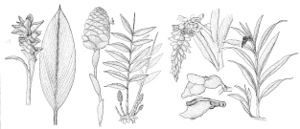Zingiberaceae
Herbs, perennial [annual], from tuberous rhizome [tuberous roots]. Aerial stems present or absent, unbranched. Leaves basal or basal and cauline, in 2 ranks, differentiated into basal sheath, petiole, and blade, or petiole absent; sheaths often overlapping to form pseudostem, open, ligule present, summit of petiole not differentiated; blade with lateral veins parallel, diverging from prominent midrib. Inflorescences 1 per aerial shoot, terminating short stem without laminate leaves or projecting from tip [side] of pseudostem, pedunculate racemes of flowers or of 2–7-flowered monochasial cymes (cincinni); bracts of main axis enclosing or subtending flowers or cincinni. Flowers bisexual, bilaterally symmetric; sepals and petals differentiated, sepals 3, connate, petals 3, connate, but sepals free from petals; fertile stamens 1, not petal-like; anthers 2-locular; 2 connate staminodes forming petal-like structure (lip) opposite fertile stamen, sometimes also with 2 petal-like or rudimentary distinct staminodes; ovary inferior, 3-carpellate, [1-]3-locular, all locules fertile; placentation axile, parietal, or ± basal; ovules many per locule; style held between pollen-sacs of anther, filiform; stigma funnelform, sometimes slightly 2-lobed; style base free from stamen and staminodes. Fruits capsules or berries; sepals often persistent in fruit. Seeds: aril present; endosperm copious; perisperm copious; embryo straight.
Distribution
Introduced; North America, Mexico, West Indies, Central America, South America, Asia, Africa, Australia.
Discussion
Zingiberaceae are tropical, the most diverse family in the Old World. Species of Zingiberaceae are often spicy to the taste, and many of them have been used as medicines and flavorings. The most important commercial spices in the family are ginger, turmeric, and cardamom.
Species of the large tropical American genus Costus Linnaeus, sometimes included in Zingiberaceae but now usually placed in a separate family Costaceae, are cultivated as ornamentals in peninsular Florida and the Gulf Coast. They are known to propagate spontaneously within gardens in Florida and might be expected to escape in disturbed habitats. Species of Costus are perennial herbs with erect stems ca. 1 m tall. The leaves are inserted in many ranks and arranged in a very distinctive open spiral; they consist of a basal sheath, a very short petiole, and a blade; the sheaths do not overlap to form a pseudostem; and the blades have parallel lateral veins diverging from a prominent midrib. The inflorescence is a terminal spike with a large bract subtending each flower; the flowers are bisexual and bilaterally symmetric, with three connate sepals and three connate petals. There is a single fertile stamen and opposite it a petal-like lip representing four fused staminodes; the fruit is a 3-locular capsule. Costaceae differ from all related families in having a well-developed aerial stem with the leaf sheaths not overlapping to form a pseudostem and in the very distinctive leaf arrangement.
Genera ca. 50, species ca. 1300 (4 genera, 4 species in the flora).
Selected References
None.
Illustrations
Key
| 1 | Inflorescences lax; bracts on main axis of inflorescence minute, scalelike; cincinni stalked, each cincinnus enclosed in large, conspicuous bracteole | Alpinia |
| 1 | Inflorescences dense; bracts on main axis of inflorescence lanceolate to reniform, 2–9 cm; cincinni sessile, each cincinnus enclosed in bract, bracteoles small, inconspicuous, hidden by bracts. | > 2 |
| 2 | Inflorescences projecting from tip of pseudostem; filament linear; anther long-exserted | Hedychium |
| 2 | Inflorescences terminating short stem with only scale leaves; filament rectangular or nearly absent; anther enclosed in corolla. | > 3 |
| 3 | Inflorescences cylindric; bracts spreading; proximal bracts ovate, apex obtuse; distal bracts larger, narrowly ovate, apex rounded; lateral staminodes petal-like. | Curcuma |
| 3 | Inflorescences conelike; bracts imbricate; proximal bracts reniform or very broadly ovate, apex broadly rounded; distal bracts smaller but otherwise similar to proximal bracts; lateral staminodes absent or reduced to small teeth adnate with lip | Zingiber |
